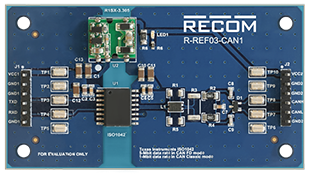SSZT560 january 2019 ISO1042 , ISOW7841 , SN6501 , SN6505B
Jan 9, 2019
As I covered in my previous post, the use of the isolated Controller Area Network (CAN) standard is increasing in both industrial and automotive applications. With higher voltages being used in these end applications, isolated communications are becoming imperative when protecting the low-voltage microcontroller while also reducing noise. But just adding an isolated CAN transceiver is not enough.
Isolated power supplies are necessary to power the two sides on an isolated CAN device. Some systems already have an isolated power supply (flyback, buck) for other purposes, so adding one extra winding to the isolation transformer for the CAN interface is easy. However, when there is no isolated power supply available, you may need to create one for the isolated CAN device, either with discrete components or integrated options.
Discrete Solutions for Isolated Power
Figure 1 shows two ways of implementing a discrete solution for an isolated CAN signal and isolated power. For isolating CAN, you can either choose a single-chip isolated CAN device (like the ISO1042) as shown on the left or use a discrete isolator (like the ISO77xx) with a discrete CAN transceiver (like the TCAN1042), as shown on the right. Choosing the latter option gives you more flexibility to select any CAN transceiver that meets your needs.
 Figure 1 Discrete Implementations of Isolated CAN and Power
Figure 1 Discrete Implementations of Isolated CAN and PowerA discrete implementation of the isolated power supply, as seen in the TI Automotive Reinforced Isolation CAN and Automotive Isolated CAN and Power Front End reference designs, enables more flexibility in the voltage and current specifications based on the transformer windings ratio. In this case, the transformer and isolator/isolated CAN device need to meet the isolation ratings of the end application.
Integrated Power and Data Solutions
Figure 2 shows a way to integrate the signal and power in a single chip. The ISOW7841 digital isolator is a single-chip isolated data and power device that provides 3.3 V or 5 V at the output and 130 mA at 5 V on the isolated secondary side. Connecting a discrete CAN transceiver to the isolated power supply of the ISOW7841 provides a complete system solution. With just two components to build this subsystem, this solution, featured in the TI Isolated CAN Module with Integrated Power reference design, is compact; reduces the time to design the isolated power supply; and eases the number of certifications necessary, as only the ISOW7841 device needs to be certified from isolation agencies compared to the discrete implementation. In addition, because of the small height of the package, the space reduction is also in the Z dimension, which enables board stacking in space-constrained applications.
 Figure 2 Integrated Implementations of
Isolated CAN and Power
Figure 2 Integrated Implementations of
Isolated CAN and PowerPower Modules
Another solution for isolated power is to use isolated power modules, as shown in Figure 3. For example, Recom’s R1SX-3.305/H-isolated DC/DC converter operates from 3.3 V or 5 V to provide a single unregulated 3.3-V or 5-V output. Using this module in conjunction with an isolated CAN transceiver like the ISO1042 provides a complete isolated solution for the CAN bus. Recom’s R-REF03-CAN1 reference board enables quick development and analysis of isolated CAN bus systems.
 Figure 3 Isolated Power Using Power
Modules
Figure 3 Isolated Power Using Power
ModulesWith various options available to isolate CAN signals and power, the decision of which solution to choose will depend on the isolation specifications, CAN performance, power requirements, space availability and ease of design. For more design flexibility, a discrete solution may be more preferable, while the integrated solution is compact and reduces design time, making it suitable for space-constrained systems.
Additional Resources
- Check out TI’s isolation portfolio.